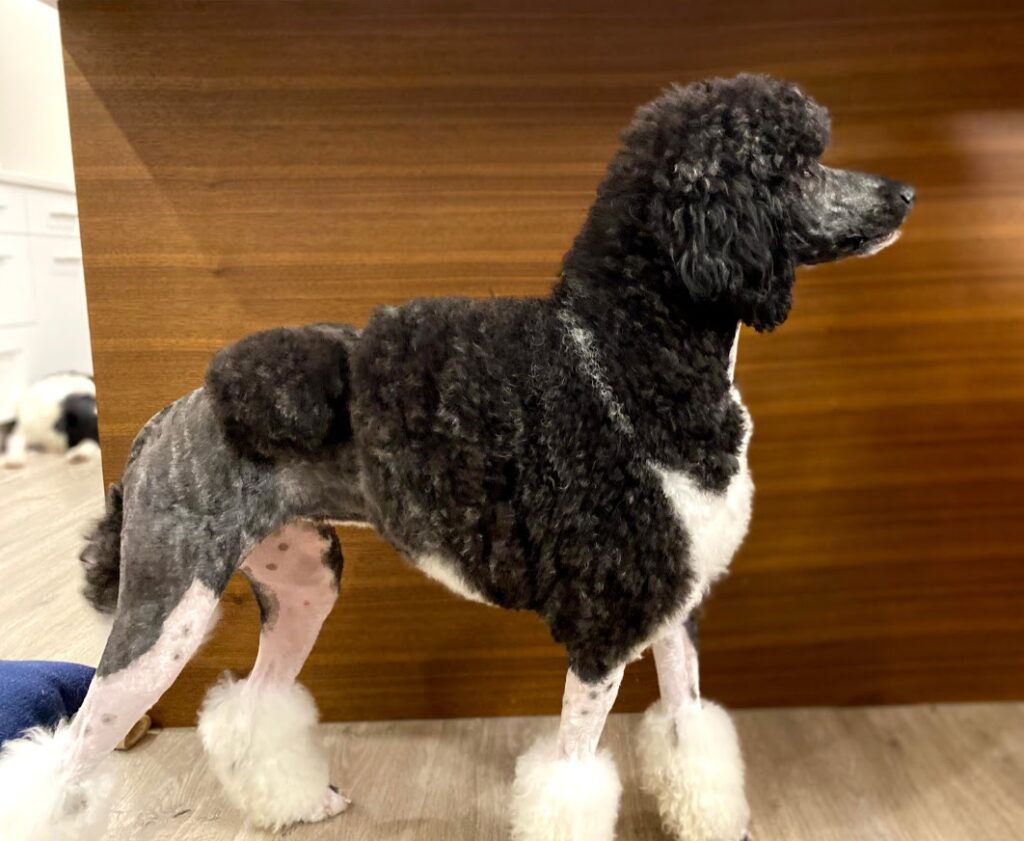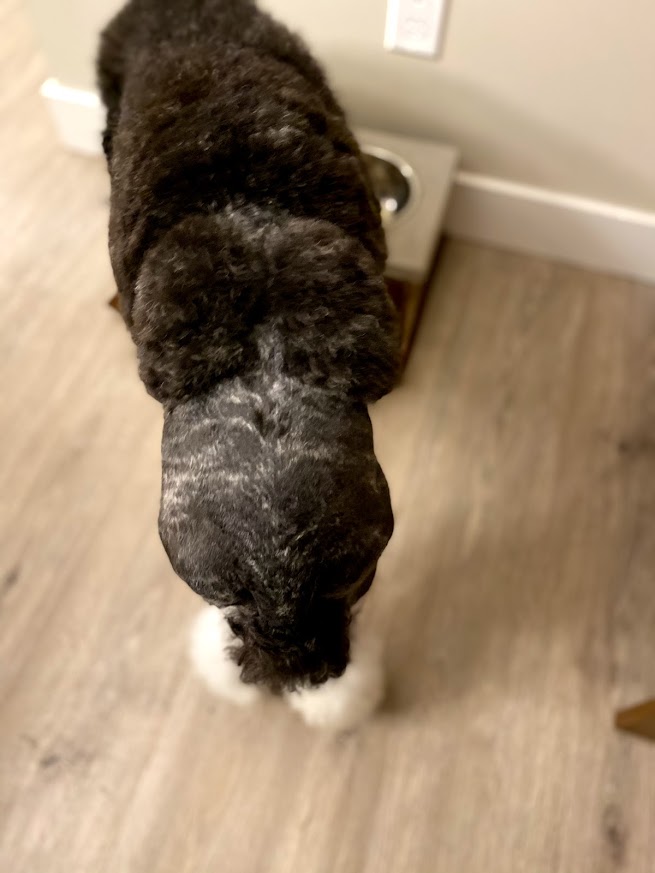Poodle Colour Basics
Originally I wasn’t going to write about poodle colours, thinking there were many great sites and resources on the web, in fact, I’ve pointed to a few of them on our Poodle Facts page.
However, after many interesting questions, answers and conversations I’ve come to believe a page devoted to poodle colours basics might be welcome amongst the Soletree Poodle community. So with further ado, let’s jump in.
Poodles offer an incredibly wide range of options, not only in terms of size (from tiny toys to big standards ranging from approximately 4-84 pounds!) but also in a rainbow of colours.
Firstly, a look back. Surprisingly to some, the original poodles were parti coloured (well, parti is not actually a colour but a distribution of colour – more on that later) and they were a hunting breed used to retrieve birds from the water. In fact, the signature poodle cut (called the Continental) with the bracelets and puffy hair-jacket hails back to this era when it was thought that leaving the hair covering the vital organs and joints would protect the poodles in the cold water as they went about their work. As their popularity grew and aristocrats in European cities began to take notice of their gentle and loyal nature they began to covet them as companions. A shift began to occur; more poodles in the cities. Perhaps not surprisingly, the aristocrats preferred to have their poodles distinguished from their working counterparts and, as such, a preference towards solid coloured ‘urban’ poodles immerged. The parti lines began to be seen as more the working dogs, while the solid dogs more urban and high-brow, if you will. Of course, this is ancient history now but the trend has carried forward in some ways.
The trend affected breeding practices and, accordingly, the solid poodles began to outnumber the parti lines and as a result, to this day, you are more likely to come across a solid poodle than a parti. I can not count the number of times I am stopped on the street by people asking what kind of dogs I have followed with the common remark “I didn’t know poodles came in those colours, stunning!”,
However, it is not only the parti poodles that are head-turners. Many of the patterned poodles make quite the impression. Is it their stunning colour or poised grace that captures people’s attention? Most likely a combination! I would be remiss not to mention the solids as stunning, as well. Solid poodles dominate the show ring. In fact, in most poodle associations, solid poodles are the only option in the conformation ring. There is nothing like an inky black or cloud white solid poodle to perfectly highlight their grace, movement and structure.
If you are new to poodles, firstly, welcome! Secondly, below I will provide an overview of the world of poodle colours. I will discuss the basic colours, the terms used to describe them and how to identify them, in general terms. There remains a lot of confusion around poodle colour, probably a reflection of the sheer number of colours and patterns. To complicate it further, almost all poodle puppies change colour as they grow, usually fading, occasionally growing darker.
Regardless of the colour, there are breeders who love and strive to produce them all. Some lines are bred to intentionally fade over time, other lines focus on retaining colour intensity… and everything in between. At Soletree Poodles we focus on producing perfectly-sized companions in a wide variety of patterns, and solid black and browns. At this point in time, none of our dogs can produce white/cream/apricot/red poodles, although our stud dog Soletree’s Soleil can produce these colours if bred to an outside female.
In this article, I will organize and present the colours in terms of how dominant they are from a colour genetics point of view. In other words, when you look at a dog’s colour genetics you always read them in the same order. The first stop is the E locus to determine if your dogs will be white/cream….
We are happy to support other breeders by featuring pictures of their dogs to help us all learn about poodle colours. All poodles featured are proudly Canadian. These pictures have been provided by the owners and permission given to Soletree Poodles to use the pics. Please do not take them without expressed permission. When provided, the link to the breeder's site has been embedded into the text with the picture, just click on it!
Please also note that we do not know all these breeders. Please do your own research to help you decide who is the right breeder for your next poodle.
Would you like me to include a picture here of your beautiful poodle's colour? Please send me a picture!
Soletree Poodles would love this page to grow and showcase not only beautiful poodle colours, but also other Canadian poodle aficionados.
White / Cream / Apricot
White-spectrum poodles are all e/e, meaning they are homozygous for recessive red. Cream, Apricots and Reds are all part of the same White family. It can be a bit confusing to hear the red intensity genes are responsible for whites, but the recessive reds genes work together to determine the saturation, or intensity of the reds, with white being the lightest. Science is just beginning to shed light on how a number of genes work together to determine intensity.
e/e dogs can not display any other colour, aside from black or brown points. Brown points (nose, eyes etc) are considered not desirable in the show ring, although some people like the look. Although these dogs can not display other colours themselves, what colours they can produce depends on their ‘hidden’ genes and who they are bred to.
Pure white poodles are born white, but many creams will fade to almost white. Remember, most poodles fade as they age. To recap, genetically the white family includes four colours:
- White,
- Cream,
- Apricot,
- Red.
Evie from Montreal is a cream, 7 months
Evie at 1 year, faded to almost white
Jade is cream with brown points
Dior is cream with black points
Sue's apricot puppy
Sara Craig's Apricot
Wynona's cream puppy, Bob
Brown / Cafe Au Lait / Silver Beige
Yes, Brown, not chocolate. Be forewarned, if you say your poodle is chocolate, other poodle aficionados might stop listening to what comes next. Joking, not joking:) There are various terms to describe colours that are breed-specific, and this is one of them. The term chocolate (or liver) might describe a poodle colour perfectly, but, chocolate (or liver) is not an ‘official’ poodle colour, and therefore not the correct word to use.
All brown poodles are genetically b/b. It is impossible for a brown poodle to have any black on its body, including its eyes, nose and pads (its points)
When a brown poodle inherits fading genes from one parent, it will fade to a lighter brown called a Cafe Au Lait.
Ch Glicks Speranze Primavera. He is a Cafe
When a poodle inherits fading genes from both parents, it will fade quite drastically over time to a colour called Silver Beige.
As of right now, breeders can not test for fading genes. Although, poodle breeders are working with genetic scientists to offer the test to the public in the near future. As a result, the amount of fading to produce a Cafe or Silver Beige is predicted by breeders based on phenotypes (what the puppy and the dogs in the pedigree looked like). To recap, in the brown family, there are three colours:
- Brown poodles (breeders will usually aspire to produce a brown that will retain (hold) that rich brown colour well into adulthood)
- Cafe Au Lait (The poodle will fade to a smokey brown or coffee with milk colouration over time). Note that the term lilac or isabella are both non-poodle terms, and relate to a different gene that causes the fading.
- Silver Beige (The poodle will fade drastically to the point it has just a hint of brown over time)
All these Brown poodles will be born dark brown. Breeders will be able to predict the adult colour after about 4 weeks when faces are shaved and reveal the colour at the root of the hair. As a poodle grows it will start to gradually change colour and loses its fluffy, looser puppy coat. This process of gradual change until the adult colour is achieved is called Clearing.
Shirley Lovita's Brown boy from Courtiere's Poodles
All Brown poodles have brown points!
Shirley Lovita's brown boy
A Brown Poodle
An older brown poodle who has faded
Black / Blue and Silver
Inky blacks are striking and retain their colour as they age, generally. They are also notoriously difficult to photograph!
Genetically black poodles will have at least one E gene (remember e/e makes for a white-based dog because black pigment can not be produced in an e/e dog) Accordingly, an E/e or E/E dog can produce black pigment, but we have to look at the K gene next to see how that black base will be displayed. If the dog has one copy of KB, it will be black based and not express any other colour patterns. KB is the dominant K gene, so if a dog has even one copy, it will be black and not have a pattern. See below for K gene explanation and the possible patterns below.
Just as with the brown poodles, there are three variants in the black family, depending on the fading genes (yet untestable, but coming soon) inherited from one or both parents. There are:
- Black
- Blue (one set of fading genes inherited from one parent) The adult blue poodle will be a soft black, in the range of dark grey/gunmetal colour. Note poodles are almost never ‘grey’ (greying is a different gene), so the term Grey should not be used to describe Blue or Silver.
- Silver (two sets of fading genes, one from each parent). A silver poodle, just like the silver beige in the brown family, will fade dramatically as it clears to a silver colour.
In both blue and silver, there is a range of fading that occurs and because there is no definitive test (yet), the classification falls to what the poodle looks like and its lineage to decide if the dog is blue or silver. As a result, I find some variance in how dogs are labelled when they fall close to the dividing lines between colours. Here are some pictures to give you an idea between blue and silver. Everyone agrees, black is pretty easy to classify:) Many poodle colour blogs are monopolized by the question “is my dog blue? (or brown equivalent – Cafe) or, “Is my dog silver? (or brown equivalent – Silver Beige) which further demonstrates that it is sometimes hard to tell.
Whether a poodle is blue or silver becomes more apparent over time. Looking back at the parents is very helpful. For example, two silvers can only have silvers, because as you now know, both parents will throw the fading genes so all puppies from that cross will have two sets of fading genes. A blue, on the other hand, has fading genes from one parent and not the other, so the offspring will be 25 -50 percent blue, statistically.
A puppy’s shaved face will show if it is silver by 4-5 weeks of age, but blue can be slower to present itself. In the bright sun, it may look like a blue pup has brown tips to the hair. A final note is that both blue and silver poodles cover a range of colours; a blue can be quite light in final colour and a silver can range from very light silvery grey colour to a pale grey.
Silver - note the silver muzzle after puppy's first shave
Blue - note the darker muzzle - harder to tell this pup will be blue
Sterling is a silver and 1.5 years old - still clearing
Charlie is 7 Months here (black)
Bo belongs to Ashley Watkins, a stunning black
Cremlulas Mr. Bojangles
The K Locus
The K locus determines if your dog will be solid (KB) or be able to express a pattern (ky and kbr). Up until now, it’s been fairly easy to determine if your dog is solid White (or cream, apricot or red… e/e at the E locus) or solid Brown (b/b) or solid black (E/_ and B/_). But enter the K gene to unlock a whole spectrum of patterned poodles.
The K gene has three possibilities, in order of dominance: KB, Kbr, Ky. Lets look at each one individually.
KB – If a dog has only one copy of KB, it will be solid. As we learned above, whether that is solid White, Black or Brown will depends on the E and B. But if the dog has one KB no pattern can be expressed.
Kbr – This one controls brindle and gets a bit tricky. A brindle dog is striped (the black pigment interrupted intermittently) and each one is unique. A brindle poodle can have a wide range of how these stripes vary in terms of striping frequency and overall end colour. Some are very dark, almost black, and some lighter. The hairs on a longer coat on a brindle dog blend together to make a muted look making it difficult to tell if they are brindle at all. In puppies, often shaving the base of the tail will reveal the brindling. Note the hairs themselves are not two-toned, some are black and some are a lighter shade.
Genetically, Kbr serves to interrupt how the black pigment is formed and laid down, which leads to the striping. Unfortunately, the randomness of the pattern also makes it untestable at this point (geneticists can not go to a specific location to look for kbr). In other words, the random nature of the striping would mean looking for a needle in a haystack for the scientist, so although they have established that kbr is responsible for breaking up black pigment, they can not at this point look for kbr in each dog.
As a result, brindle is determined by looking at phenotype (what the dog actually looks like) versus genotype (what the dog is genetically). Accordingly, if your dog is brindled you know it has at least one copy of Kbr, but the genetic test will come back as KB/ky, or some combination. This leads to a lot of confusion as the K test on a brindle dog will not be accurate. Note that Kbr is ranked in the middle of KB and Ky in terms of dominance, so a brindled dog can not be KB/KB. Every brindle dog is either kbr/kbr or kbr/ky. Whether the dog has one copy of kbr or two is not testable but can be determined by examining pedigrees and/or breeding to see what you get. For example, if a dog who appears brindle all over comes from a sable dam and brindled sire, you would know the dog would be kbr/ky (kbr from the sire, ky from the dam). Further, the A locus comes into play with how brindle will be displayed, which will be discussed further below. For now, know that
Brindle plus sable (ay) or wild agouti (aw) = Brindling all over the coloured coat
Brindle plus Phantom (at) = Solid body with brindled points (the tans areas on the phantom pattern will be brindled)
Ok, now on to ky, the recessive or lowest on the hierarchy in terms of dominance. As we know a dog needs two copies of a recessive gene for it to have an impact on what colour a dog becomes. Therefore, only when a dog gets a ky from each parent will the next gene be unlocked. Once ky/ky is in play the dog will display a pattern, we move the A gene to determine what pattern the dog will be (wild agouti, sable, or phantom and much less often….seal or creeping tan)
Soletree's Marseille is a beautiful example of brindle and how it can be hard to see unless the hair is short. Look at her black jacket, which could leave some question as to whether she is brindle or not, as compared to her rump where the lines are very clear:


The A Locus
Every poodle has two genes on the A Locus, just as above with the other genes. The question is, when will the A locus be “allowed” to be expressed? We learned above that that question is answered by the K locus. If the K locus is ky/ky, then the magic of the A locus can be seen on the poodle coat. It is important to note that the A locus does not determine colour, but rather where the colour will be; or, in other words, the colour pattern on the poodle. The two most common A locus gene are Ay (sable) and At (phantom). Lets take a closer look at each.
Sable
I once heard sable described as “black born apricots” and I think this is an excellent way to describe them. At birth a sable puppy will appear very dark as the tip of every hair is black. The gene is the same one that gives wolves distinct black-tipped hairs. But, and this is a big but: further down the black-tipped hair shaft, it is all light coloured. And, because poodles have hair that never stops growing, most of those black tips will get cut off permanently as the dog ages. As a result, the sable puppy will get lighter and lighter until it reaches some shade lighter colour. How light, you ask? Anywhere from cream to dark apricot, only time will tell. Often the black tips are retained longer around the ears.
Phantom
At/ at the A locus will result in a phantom pattern. It is recessive to sable, meaning if the poodle is ay/at, the poodle will be sable (but carry phantom). Think of a Doberman Pinscher and you are seeing a phantom colour pattern in your mind’s eye. In poodles, phantoms can be black-based or brown-based while their points (the tan parts on a Doberman) can vary from white to deep red. The science behind the point colour and intensity of that colour is still being studied by experts.
Other A locus mentions are the aw, or wild agouti. This pattern is the most dominant of the A genes, although not as common. It expresses similar to Sable (ay). On the other end of dominance is the recessive black gene, expressed simply as ‘a’. a/a poodles are sometimes referred to as ‘Bad Blacks’ (an unfortunate term). These poodles will appear all black, even if they are EE, ky/ky, a/a.

